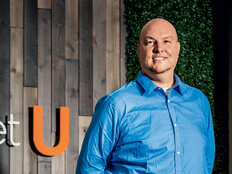Tech’s Crucial Role for Patients and the Bottom Line
A nurse prepares a patient for surgery. The software on the bedside monitor indicates she needs to start an IV drip, so she scans the bar code on the IV bag before administering it to the patient. She’s been a nurse for more than 40 years, but she still appreciates the prompts.
The system helps ensure that the right medicine, in the right amount, goes to the right patient, part of a safety protocol known in healthcare as The Six Rights of Medication Administration. And today’s hospitals are filled with such technology, making a quantifiable impact on health as well as overall patient satisfaction.
For the past 10 years, technology has streamlined care with check-in kiosks, mobile apps and patient portals, giving patients more control over their health.
Those advances are much more than feel-good technologies: Patient satisfaction makes a measurable difference to every provider’s bottom line, in more ways than one. Public surveys taken by the Centers for Medicare & Medicaid Services measure the performance of all hospitals, and higher scores result in both a better reputation and more substantial reimbursements.
There’s a strong link between patient technology and satisfaction, even though patients and providers don’t always see eye to eye. In CDW Healthcare’s Patient Engagement Perspectives survey, 60 percent of providers said that improving patient engagement is a top priority, but only 35 percent of patients thought their provider was doing a good job engaging them.
However, both patients and providers agreed that the two most valuable methods for encouraging their engagement are web-based access to healthcare information and online patient portals. The survey notes that 67 percent of providers are working on making healthcare records easier to access.
Technology’s Invisible Impact
Finding ways to share information with both patients and providers is a passion for Bobbie Byrne, executive vice president of consumer-driven health and CIO of Edward-Elmhurst Health, an integrated health system that serves patients in the west and southwest suburbs of Chicago.
She’s found that multiple factors affect how patients rate their doctors and hospitals. The patient flow mechanism at Edward-Elmhurst is one example of how her health system improves satisfaction — and patients don’t even know it’s there.
At Edward-Elmhurst, if a patient has an MRI at 11 a.m., the system automatically works out a schedule to engage transport at 10:45 a.m. and lunch at 1 p.m. If an emergency comes up, the nurse gets a mobile phone alert. Transportation and lunch delivery go on hold until the nurse reschedules the MRI. The system even ensures that patients get enough quiet time to rest.
“It’s patient-centric,” Byrne says. “Because there’s so much sharing of information behind the scenes, everything is seamless. Patients don’t know what the technology is doing, but they rate the experience highly. They think they have a ‘super nurse,’ and that’s fine with us.”
Other technology, such as mobile apps or patient portals, help providers communicate directly with patients. But not just any mobile app can have a measureable effect on patient engagement — it needs to be built and used effectively.
“These technologies need to follow the ‘five rights’ of consumer communication. They should be with the right consumer, with the right message, at the right time, for the right reason, on the right channel,” says Lynne Dunbrack, research vice president for IDC Health Insights.
Dunbrack also notes that mobile apps should be intuitive, and fit into patients’ workflow and daily life.
“If the apps are hard to use, don’t work as expected, or are slow and prone to crashing, then consumers will abandon them,” she says.
Keeping Patients Engaged
Healthcare providers are continuing to invest in technologies that engage patients. A recent survey by IDG reveals that personal health records, remote health monitoring devices and social media top the list of programs they plan to expand in 2017 to support consumer engagement. Dunbrack says that these technologies need to be relevant.
“Technology should be easy to use, nonintrusive, and provide actionable information for consumers to find value and want to continue using it,” she says.
On the provider side, the University of Colorado Health System (UCHealth) is focusing time and energy to further optimize the electronic health record (EHR) for clinicians, CIO Steve Hess says.
“A surgeon uses technology differently than an infectious disease specialist,” Hess says. “It’s our job as the IT department to optimize the technology for users. Then, technology becomes an enabler of quality, safety and experience. That’s the differentiator for our patients.”
Using Technology to Invoke Change
EHR is considered fundamental in most hospitals. According to the Office of the National Coordinator for Health Information Technology (ONC), nearly 85 percent of hospitals have a basic EHR system.
Like many healthcare systems, UCHealth is the result of several mergers. Typically, merging several EHRs into one isn’t so easy; for Hess, collapsing three systems into one took about two years.
“We moved fast on purpose,” he says. “A lot of organizations spend years implementing the base EHR, and it feels like you work for the EHR. Now, we’ve made the EHR work for us.”
Hess and his team employ department-specific changes to the EHR to make a major impact. In the emergency department, the IT staff worked with clinicians to embed pathways — specific protocols that clinicians follow for each patient who visits the ER — directly into the EHR. In less than a year, the number of patients served per month more than tripled, and the total amount of time patients spend in the ER fell dramatically, Hess says.
“We’re going through each department like a SWAT team,” he says. “The EHR provides us with good data, but it’s not enough to present the departments with simple charts about their activities. We turn the data into advanced intelligence and hardwire it back into the EHR so that the learning is being used.”
Machine Learning and More
Beyond EHRs, healthcare organizations increasingly work with newer, next-generation technology such as machine learning, radio frequency identification (RFID) and remote health monitoring.
Back in UCHealth’s oncology department, running out of infusion chairs was a major issue, occurring 61 percent of weekdays. After implementing machine learning to help solve the situation, the department now runs out of chairs just 5 percent of the time. Providers can see more patients as well as cut staff overtime. Altogether, the changes are expected to produce about $2.8 million more in revenue each year, Hess says.
“That increase in net revenue is based on the 7 percent increase in patient volumes due to the efficiencies gained,” he adds.
The use of RFID is also becoming more common in day-to-day hospital care. RFID technology has been used in maternity wards for years to ensure that newborns are with their correct mothers, but now the chips are embedded in everything from wheelchairs to patient ID bracelets, helping hospital staff to pinpoint a person or item’s location down to the square inch.
Remote health monitoring through wearable technology also offers intriguing potential. Several FDA-approved systems already allow clinicians to keep an eye on vitals such as cardiovascular activity and glucose levels. In senior care settings, in particular, remote monitoring offers the promise of less invasive care, and more freedom to live active, worry-free lives.
CDW Healthcare partnered with Intel and Big Cloud Analytics to investigate the potential benefits of wearable, device-facilitated monitoring in senior care, launching a pilot program in four communities, including Masonic Homes of Kentucky. There, residents are largely independent, so the pilot also focused on collecting and aggregating participants’ heart rate, sleep and activity data. Residents played a more active role in the pilot than at other sites, and often viewed their data as a source of motivation.
“They actually started to get competitive,” says Gary Marsh, Masonic’s CEO. “You know — ‘I’ve taken more steps than you. Let’s see if you can do a little better.’ ”
Discover how to support and prepare the IT environment for such critical patient-centered initiatives by reading CDW’s white paper, “Healthcare Technology and the Patient Journey.”









